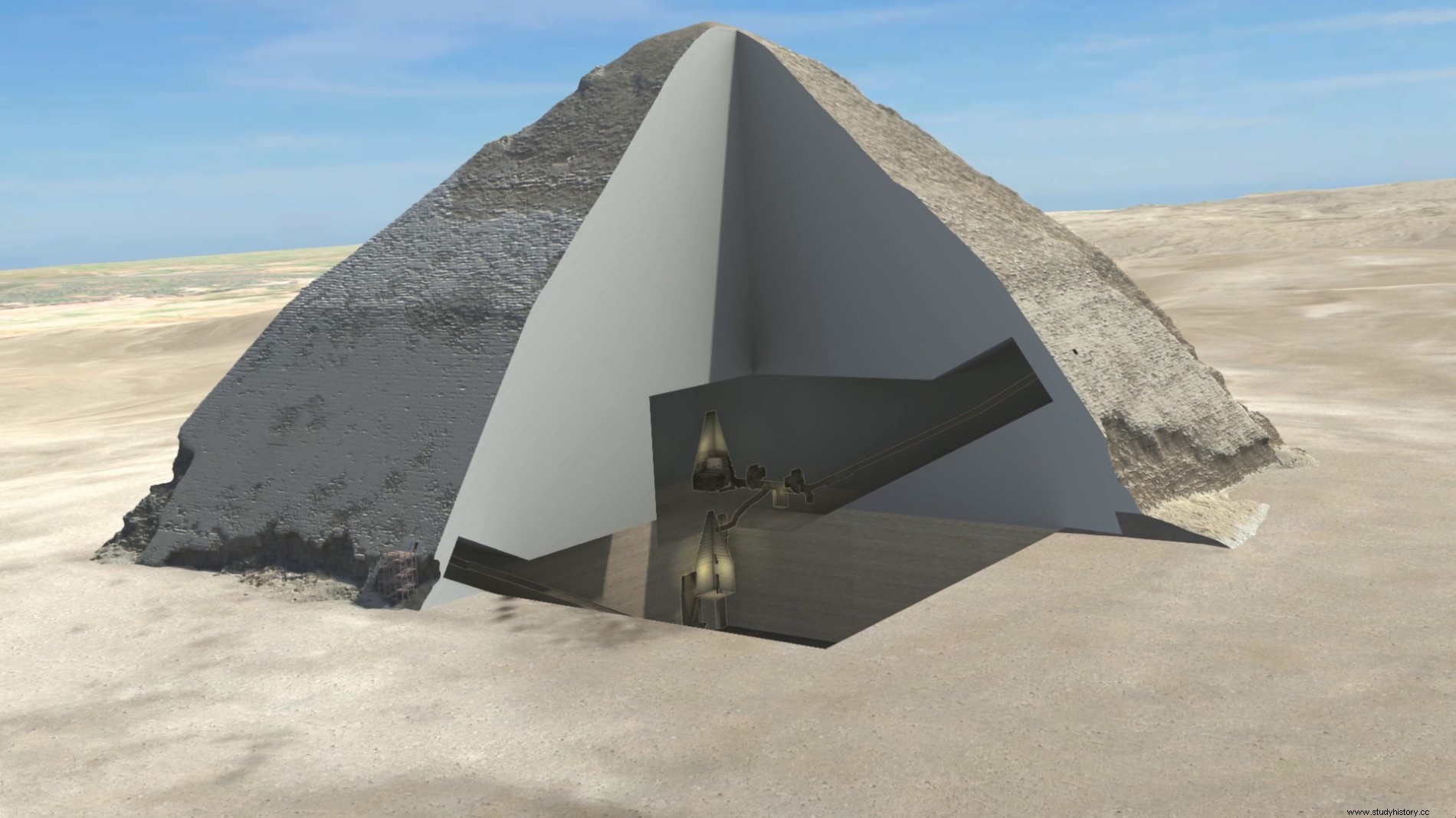This is a major scientific first that has just been announced in Egypt as part of the Scan Pyramids mission! The heart of an Old Kingdom pyramid has been scanned using cosmic particles:muons.

The internal structure of Dahshur's rhomboidal pyramid was revealed by the muon technique.
Muography is one of the particularly futuristic techniques deployed by the Scan Pyramids mission. Launched in October 2015 by the Faculty of Engineering in Cairo and the French Institute HIP (Heritage Innovation Preservation), this international project aims to bring together the most innovative non-destructive technologies in order to probe the heart of the great funerary monuments of the 4th dynasty. Like the X-rays that pass through our body and allow us to visualize our skeleton, muons, a kind of heavy electron, are capable of crossing very thick rocks and x-raying monuments in depth. In December 2015, the team of Professor Kunihiro Morishima, from the University of Nagoya, deposited in the lower chamber of the rhomboidal pyramid of Dahshur forty plates each containing 2 films sensitive to cosmic particles, on a total surface of 3.5 square meters (see below the 3D image of the pyramid; click on it to see it larger) . Due to the fragility of chemical emulsions, which can be affected by heat and humidity, the plates could only be left in the monument for 40 days. Developed in a laboratory specially set up at the Grand Egyptian Museum in Cairo, the films were analyzed at the University of Nagoya using an automatic microscope unique in the world (see photo in our slideshow, at the end of our article) , specially developed for the mission.

In this 3D image of Dahshur's Bent Pyramid, we can see the lower chamber in which the muon plates were placed, and the upper chamber. © Egyptian Ministry of Antiquities, HIP Institute and the Faculty of Engineering (Cairo University), Egyptian Ministry of Antiquities, HIP Institute and the Faculty of Engineering (Cairo University)
The Japanese team was able to reconstruct more than 10 million muon trajectories. And obtain images that highlight the internal structure of the pyramid in the muon vision cone (see 3D image of the cone, in the slideshow at the end of this article) We can see the upper chamber (16 meters high and about 8 meters long), which is about twenty meters above the lower chamber in which the detectors were placed. The corridors, small in size (1 meter in section), do not yet appear clearly on the muographies (see our infographic, below) . The exposure time did not allow enough particle traces to be acquired for these small spaces. The system works like a photographic emulsion which in low light conditions (with few photons) requires a long exposure to light. On the other hand, if there existed in the heart of the pyramid another room of size equivalent or superior to those known today, the images would show them. This is not the case.
1/ 3D view of the Bent Pyramid from the floor of the Lower Chamber. This image precisely shows the structures of the monument such that the muon plates, placed on the ground, could "distinguish" them through the mass of stones, behind the corbelled roof of the room.
2/ Simulation. In order to verify the validity of the technique, the ScanPyramids team carried out a simulation. It shows the image that should be obtained after an infinite theoretical exposure time of the emulsions. We clearly distinguish on this simulation the layouts of the corridors and the upper room.
3/ Result. The image obtained after analysis of the films. It is very close to simulation. We distinguish the superior room. On the other hand, the exposure time was not long enough for the layout of the corridors to appear clearly.
"We have just taken an extremely important step by validating this technique, rejoices Mehdi Tayoubi, co-director of the mission. The implementation in the field gave us a lot of information that will allow us to adjust and refine the next campaigns. For example, we are working on optimizing the chemical formulation of emulsions in order to increase their exposure time" . Next stop:Cheops. A colossal black box which should be X-rayed by no less than three types of detectors:the chemical emulsion plates of the University of Nagoya but also an electronic scintillator developed by the KEK (High Energy Accelerator Research Organization, Japan), since inside. And the muon telescopes of the CEA, which joined the mission on April 15, 2016, from the outside. The KEK and CEA instruments have two advantages over chemical emulsions:unlimited exposure time and digital data provided in real time. This exceptional device should make it possible to reveal the intimacy of the largest and most enigmatic of the pyramids. With all due respect.
IN IMAGES, IN PICTURES. The core of the rhomboidal pyramid scanned using muons



